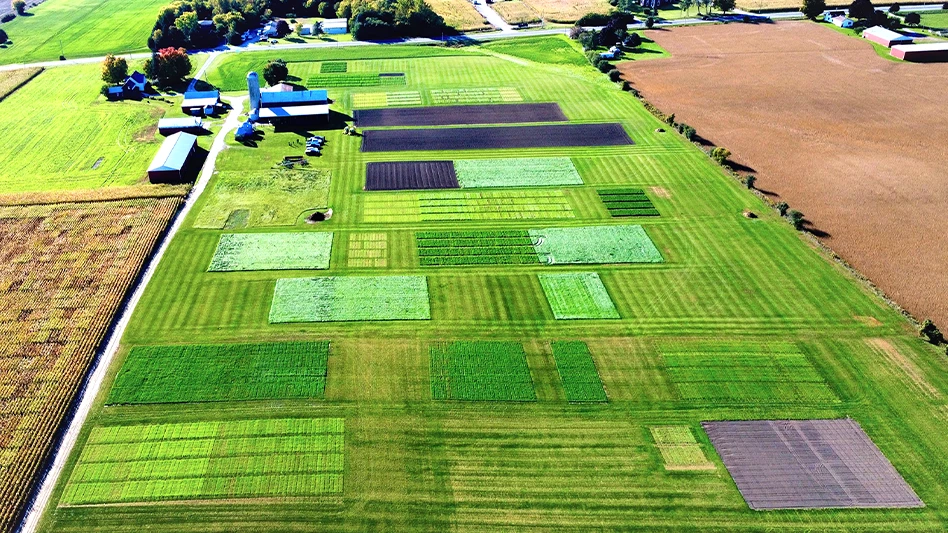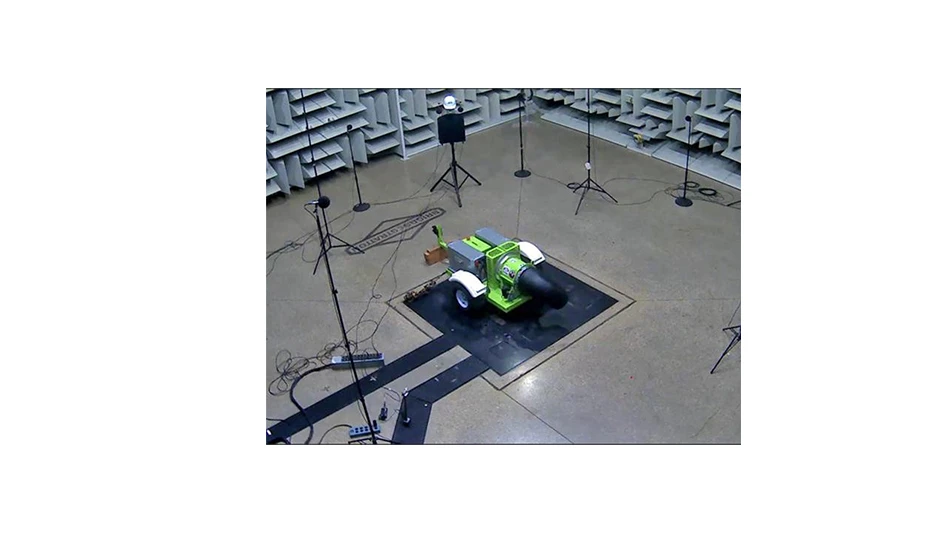On Jan. 23, 2006, Santa Ana Country Club and the PACE Turfgrass Research Institute embarked on a multimonth study to analyze greens firmness by characterizing the current situation and then identifying management practices that can help achieve more consistent greens firmness throughout the year.
Factors contributing to greens firmness were identified, with soil moisture a key component. Greens were characterized by golfers as performing well, with good surface firmness, on the aforementioned date. Based on data collected Jan. 23, a tentative range of 15 percent to 25 percent soil moisture was identified as the target for producing optimal levels of firmness (tentatively characterized as ranging from 70 to 125 gravities on a Clegg meter).
Maintaining this level of performance throughout the year will be difficult, especially during the hot summer months when irrigation demand is highest. However, practices including modified aeration, topdressing and irrigation strategies, along with a soil moisture and surface firmness monitoring program will assist in achieving the best firmness possible while still maintaining turf health and quality.
Describing the problem
The golfer controversy about greens trueness and firmness has been ongoing for many years. The following quote from the U.S. Golf Association’s “Timely Turf Topics” in May 1947 illustrates the persistent focus on firm and true greens:
“Putting surfaces should be firm to avoid foot printing and should be resilient so that a properly played shot will hold, but should be sufficiently solid so that a poorly played shot will roll over. The surface should be smooth and true as a billiard table. Density of the turf should be so great that individual grass blades are crowded to a true vertical position. “Graininess,” “sponge,” or “mat” destroy the accuracy and fun in golf. Governing factors include: choice of grass, soil texture, drainage and aeration, fertility level, and watering practices.”
Not much has changed in the desire of golfers for firm and true greens surfaces since 1947. Despite this, methods for addressing the problem haven’t been extensively researched and documented. This is partly because the nature of the problem varies widely from one golf course and one group of golfer’s perceptions to another. It’s also because the management practices that are required to improve firmness frequently require long-term overhauls of the greens.
Factors involved
At Santa Ana Country Club, the governing factors that will influence firmness are the same as those listed in the aforementioned quote. Unfortunately, major reconstruction is required to modify the factors most directly implicated in greens firmness. These are the nature of the root-zone sand (which should optimally be changed to a firmer mixture), the turfgrass variety (which should optimally be changed to bentgrass, which provides a firmer surface than Poa annua) and improved drainage (which, by allowing water to move more easily through the soil profile, would increase the firmness and homogeneity of the greens). Without these major changes, greens firmness can’t be fully maximized at Santa Ana Country Club.
There are, however, several less dramatic management practices that can lead to improvements. These include modifications in aeration, topdressing and watering practices.
An increased frequency of aeration will lead to firmer greens, but the compromise is that the trueness of the surface will be impacted for about 14 days following each aeration event. New, smaller diameter aeration tines might improve recovery and allow more frequent aeration to increase firmness, but increased aeration to improve firmness will have to be weighed against the negative (though temporary) impact on surface trueness. Even if increased aeration can’t be tolerated, application of sand as topdressing without aeration is a practice that might be evaluated to increase the firmness of the greens during the summer.
A second, and more controversial factor is watering practices. Is it possible to reduce summertime irrigation or hand-watering while maintaining healthy Poa? Irrigation water reduction to increase firmness carries the greatest risk. Once the soil has dried to a level that exceeds the ability of the Poa plant to extract the water, the plants will wilt and die. If the Poa dies, a minimum of six weeks of conducive weather conditions will be needed before the stand of Poa will return to acceptable putting conditions. In the peak heat of the summer, this period of time will be longer, and if traffic is allowed on the damaged areas, the time to recovery will be extended further.
Even though soil water management to levels that provide firm greens without damage to the Poa plant is a risky venture, one of goals of this project will be to determine if there is a way to reduce the risk of drying out Poa greens. How dry is safe? Can we monitor soil moisture to better adjust irrigation practices? What levels of soil moisture are adequate for the plant yet low enough to provide the desired firmness?
Soft greens have been described as greens that don’t have sufficient ball bounce and roll after driving onto the green. Additionally, soft greens are more susceptible to severe ball marking. These subjective measures of firmness will help guide management practices and development of objective measures of firmness. The current firmness of greens was reported to be nearly ideal by golfers at Santa Ana Country Club during the day of sampling (Jan. 23, 2006). The range of firmness measured during this preliminary study will be used as a benchmark to measure the impact of future management practices. These guidelines will need to be reevaluated during the year to be sure they’re valid and the health of the Poa isn’t compromised.
Sometimes fertility is mentioned as a factor in greens firmness. Fertility has been monitored at Santa Ana Country Club for more than 10 years. Soil nutritional guidelines have been managed within the range needed for good greens performance. Attempts to reduce fertility with the goal of firming greens will compromise the integrity of the Poa and increase susceptibility to diseases such as anthracnose and susceptibility to wear damage.
Measuring firmness
Firmness has been measured using a variety of tools. Baker et al. (1996) used simulated golf ball launchers that mimicked the impact of a ball hitting a green with the impact that might be typical for a 5 iron (53 degree impact angle, velocity of 22.7 m/s, backspin 750 rad/s) and a 9 iron (53 degree impact angle, velocity 18.8 m/s, backspin 880 rad/sec).
This unique research equipment isn’t available for us to use, but fortunately, Baker et al. found there was a significant correlation between firmness evaluated using the ball impact simulators and the Clegg impact soil tester. Based on their fairly extensive surveys of golf courses in Britain, a range of Clegg measurements between 70 gravities and 120 gravities was considered to result in good ball bounce and roll – not too soft and not too hard.
In a similar study conducted in New Zealand, Linde found greens reporting Clegg values of less than 50 gravities were too soft and greens that reported Clegg values of more than 140 gravities were too hard. The average for high-end golf courses in New Zealand ranged between 78 and 122 gravities. Based on this information, we have identified a range of 70 gravities to 125 gravities as an initial target for the Santa Ana Country Club. This range will be modified, if necessary, as work progresses.
The Clegg values observed at the Santa Ana Country Club during this preliminary study ranged between 62 gravities and 125 gravities. Based on this initial research, the greens are currently performing almost completely within the guidelines considered ideal for golf play (only two readings were below the guideline of 70 gravities).
Golfer’s positive evaluations on firmness, obtained January 2006, confirm this conclusion. It’s expected that as hot weather and increased irrigation demands occur during the summer months, firmness might decline. It’s during the warmer months that the greatest challenge in terms of maintaining green firmness occurs.
Measuring soil moisture
Soil moisture conditions also were monitored during the Jan. 23 evaluation. The correlation between low soil moisture and firm conditions were confirmed at Santa Ana Country Club (Figure 3). Soil moisture levels ranged between 14 percent and 32 percent, although the majority of readings were within the guideline of 15 percent to 25 percent moisture. For sand-based greens, we generally target a range of roughly 15 percent to 25 percent for optimal turf growth and optimal firmness. Although moisture levels below 15 percent produce good firmness, turf health might be seriously compromised. A reading of 12-percent soil moisture resulting in turfgrass stress and damage.
Targeting soil moisture from 15 percent to 25 percent, and with Poa plants having roots that can extract water from the top 1.5 inches of soil during the summer, the plant will have just enough water to make it through a maximum water demand (evapotranspiration) day in the summer – about 0.3 inch of water. For that reason, the surface moisture in the top 1.5 inches of soil will almost have to be replenished daily.
If the Poa plant were capable of forming longer roots, less water would need to be applied daily because the deeper roots would have access to deeper soil moisture. The ultimate problem we will encounter when trying to manage Poa at lower soil moisture levels is that the short roots will require almost daily irrigation or syringing. Compounding the high water demand of Poa is that water must be applied through the surface of the green resulting in a higher water concentration at the surface of the green.
A further challenge with regard to managing soil moisture relates to the inherent flaws of irrigation system designs. Compounded by the irregular shape of greens, it’s unfortunate that portions of the same green might be irrigated from anywhere between two to five different irrigation heads. This results in uneven application of water and, therefore, uneven soil moisture levels. To compensate, superintendents must combine a series of tactics, including targeted hand-watering (to areas that receive too little water), irrigation system adjustments (micromanagement of irrigation head run cycles) and constant adjustment and readjustment of the system.
By monitoring soil moisture and surface firmness parameters throughout the year, this study hopes to identify irrigation practices that can combine sometimes contradictory demands of keeping the turf quality high while keeping the playing surface as firm as possible.
A final soil moisture challenge relates to the need for periodic leaching (high volume irrigation) of the greens, especially during the summer months. Because lack of rainfall in Southern California between April and November, salts from irrigation water rapidly accumulate in the soil, where they cause problems including turf stress and death, destruction of soil physical properties and instigation of turf diseases such as rapid blight and anthracnose. Without leaching, the survival of Poa is highly unlikely. Surface firmness following leaching events will be compromised, but this is unavoidable. Improved movement of water through the greens via the recommendations below will decrease the intensity and duration of the problem.
Recommendations
Based on the aforementioned research, the follow are recommendations that were to be implemented February 2006.
- Target soil moisture between 15 percent and 25 percent. You can use a Spectrum TDR300 with 4.8 inch probes. Purchasing a soil moisture meter is recommended. The TDR 300 soil moisture probe ($1,195.00) is available from Spectrum Technologies (www.specmeters.com).
- Target Clegg impact soil tester 2.25 kg hammer deceleration between 70 gravities and 125 gravities.
- In the spring, aerify using three-eighths-inch hollow tines on a 2-inch-by-2-inch spacing and sand fill the holes using Caltega 7 USGA specification sand.
- A more aggressive aerification program than the one described above can be substituted if a club is willing to tolerate disruption of optimal golf play to achieve more dramatic results
- In the spring of the year, aerify using five-eighths-inch hollow tines and collect the plugs. Apply one-quarter-inch depth of Caltega 7 USGA specification silica sand. Vertidrain using three-quarter-inch solid tines and sweep the sand into the holes and fill all holes to the top. This process will aid in firming the entire root zone, but it will require a repeat of the process for at least three years in the spring before the process can be terminated. This aggressive program will disrupt the trueness of the greens for an extended period of time and might result in stronger Poa growth in the aeration holes that will result in a slightly bumpy surface. This negative impact can be partially managed using Primo and increased fertility.
- Lightly topdress weekly using a No. 30 sand applied at about 50 pounds per green (one bag dry sand) using a Scotts or similar rotary spreader. Nighttime irrigation will move the sand into the upper thatch layer. Although thatch has been managed well, Poa plants are producing more thatch continually. Application of increased levels of topdressing sand will help modify the thatch and mat layer and firm them up.
- During the irrigation season, implement a monthly Aqueduct application (4 ounces per 1,000 square feet) program to improve water movement through the soil profile to drain.
With Poa greens, don’t expect optimum greens performance during the months of July, August and September. Prevent turf loss during these months so that fall winter and spring greens performance will be premiere. It’s unlikely that optimum performance can be provided throughout the year. If summer is the target for good performance, more aggressive aeration will be needed at other times of the year to improve the root-zone composition and allow deeper rooting and improved drainage. GCI
Larry J. Stowell, Ph.D., CPAg is a research director of the PACE Turfgrass Research Institute (www.paceturf.org) in San Diego. He can be reached at 858-272-9897.
Citations
- Baker, S.W. Hind, P.D., Lodge, T.A., Hunt, J.A., Binns, D.J. 1996. A survey of golf greens in Great Britain IV. Playing quality. J. Sports Turf Res. Inst. 72:9-23.
- Linde, D. 2005. Assessing golf course conditions in New Zealand. Golf Course Management

Explore the September 2007 Issue
Check out more from this issue and find your next story to read.
Latest from Golf Course Industry
- GCSAA announces Grassroots Ambassador Leadership Award recipients
- Reel Turf Techs: David Gummo
- PBI-Gordon promotes two to executive level
- VIDEO: A First Green morning
- Bloom Golf Partners adds HR expert
- Seeking sustainability in Vietnam
- Kerns featured in Envu root diseases webinar
- Toro continues support of National Mayor’s Challenge for Water Conservation





